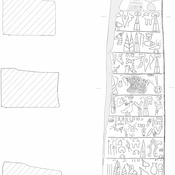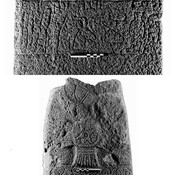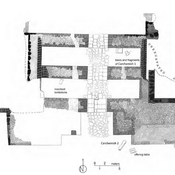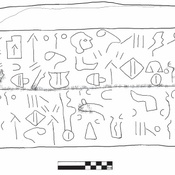Il n'y a pas une annotation en français. Présenté est une annotation en Anglais.
Carchemish was first occupied in the Neolithic Period (c. 7000 BC).The obsidian and flint blades and black burnished pottery were discovered in the earliest layers. In the royal archives of Mari, c. 18th century BC are records concerning Carchemish. It’s a place of strategic importance – controlled the main ford across the Euphrate. Karkamish may have been first occupied by Hittites for a short in 16th century BC. Later in the XV-XIV centuries remained under Mitanni - Hurri domination. The Hittite conqueror Suppiluliumas (c. 1375–35 BC) established his son as king of the city (c. 1330 BC )
The site consists of a citadel, an inner town, and an outer town.
Sources:
- http://www.disci.unibo.it/it/ricerca/archeologia/progetti-di-ricerca-1/progetto-karkemish
- Getzel M. Cohen, The Hellenistic Settlements in Syria, the Red Sea Basin, and North Africa, University of California Pres 2006, pp. 169-171
- Nicolò Marchetti eds., Karkemish. An Ancient Capital on the Euphrates. OrientLab 2, Bologna Ante Quem 2014 - http://www.orientlab.net/pubs/pdf/Karkemish_OrientLab2_lt.pdf
- David George Hogarth, Hittite Problems And the Excavation of Carchemish. London: Pub. for the British academy, by H. Frowde, 1911.
- Sara Pizzimenti, Giulia Scazzosi, The urban structure of Karkemish in the Late Bronze Age and the settlements of the Middle Euphrates Valley, in Anatolica · November 2017, No. XLIII, pp. 157-172
- Nicolò Marchetti, Karkemish on the Euphrates: Excavating a City's History, Near Eastern Archaeology, 75(3), 2012, pp. 132–147
Carchemish was first occupied in the Neolithic Period (c. 7000 BC).The obsidian and flint blades and black burnished pottery were discovered in the earliest layers. In the royal archives of Mari, c. 18th century BC are records concerning Carchemish. It’s a place of strategic importance – controlled the main ford across the Euphrate. Karkamish may have been first occupied by Hittites for a short in 16th century BC. Later in the XV-XIV centuries remained under Mitanni - Hurri domination. The Hittite conqueror Suppiluliumas (c. 1375–35 BC) established his son as king of the city (c. 1330 BC )
The site consists of a citadel, an inner town, and an outer town.
Sources:
- http://www.disci.unibo.it/it/ricerca/archeologia/progetti-di-ricerca-1/progetto-karkemish
- Getzel M. Cohen, The Hellenistic Settlements in Syria, the Red Sea Basin, and North Africa, University of California Pres 2006, pp. 169-171
- Nicolò Marchetti eds., Karkemish. An Ancient Capital on the Euphrates. OrientLab 2, Bologna Ante Quem 2014 - http://www.orientlab.net/pubs/pdf/Karkemish_OrientLab2_lt.pdf
- David George Hogarth, Hittite Problems And the Excavation of Carchemish. London: Pub. for the British academy, by H. Frowde, 1911.
- Sara Pizzimenti, Giulia Scazzosi, The urban structure of Karkemish in the Late Bronze Age and the settlements of the Middle Euphrates Valley, in Anatolica · November 2017, No. XLIII, pp. 157-172
- Nicolò Marchetti, Karkemish on the Euphrates: Excavating a City's History, Near Eastern Archaeology, 75(3), 2012, pp. 132–147





